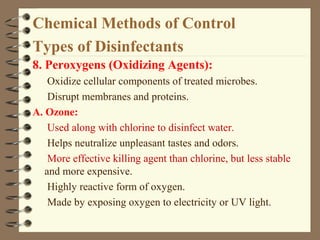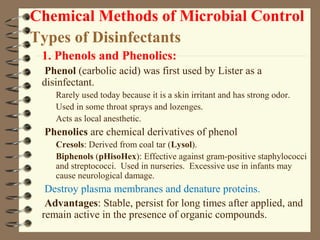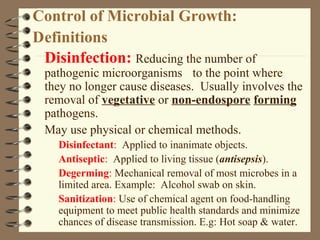Measuring minimal bactericidal concentrations. Inactivation of the drug by enzymes.
Most vegetating microorganisms are killed within two.

. Think about the conditions required for microbial growth. Determine the effectiveness of heat for sterilization. - Identify methods of controlling the growth of microorganisms.
4 ways bacteria develop resistance to antibiotics. A Decontamination b Inhibition c Destruction d Sterilisation. Explain the various methods of controlling microbial growth.
Control of Microbial Growth- Chemical Methods By Debomitra Dey 2. Recognizing how temperature impacts growth supports the importance of refrigeration. - Describe the principles of standard precautions using three examples of standard precautions.
Food additives inhibition Controlling Microbial Growth. Growth of Microorganisms With Diagram The growth of microorganisms is a highly complex and coordinated process ultimately expressed by increase in cell number or cell mass. Physical agents to control microorganisms.
Rapid detection and identification of microorganisms is a challenging and important aspect in a wide range of fields from medical to industrial affecting human lives. Other methods do not kill organisms but instead stop their growth making their population static. Nutrient and oxygen availability Temperature pH and pressure Moisture content and saltsugar solute levels.
The time of application and temperature to ensure destruction of all microorganisms. Alteration of the drugs target sites mutation 4. - Identify methods of controlling the growth of microorganisms.
Methods for Identification of Microorganisms Classical Methods In-house biochemicals Manual phenotypic methods API Strips BBL etc Automated phenotypic methods Vitek Cellular Fatty Acids MIDI Sherlock System Carbon. Microorganisms are controlled by means of physical agents and chemical agents. Unfortunately classical methods of microorganism identification are based on time-consuming and labor-intensive approaches.
Chemical methods for controlling micro organisms 1. The absence of pathogens. As described above microbes can replicate as quickly as every 20 minutes leading to visible growth within only a few hours.
List major types of infectious agents and identify methods of controlling the growth of microorganisms. The prefix indicates the type of microbe or infectious agent killed by the treatment method. General Strategies to Control Growth.
Thermal death point TDP the lowest temperature that will kill all of the organisms in a standardized pure culture within a. Epsilometer for measuring MIC. Physical agents include such methods of control as high or low temperature desiccation osmotic pressure radiation and filtration.
Such methods are identified by the suffix -stat or -static. 100 degrees fahrenheit for 30 minutes kills everything except for some endospores. Dry heat can be used in incineration devices such as the Bunsen burner or the hot-air oven.
Most important and widely used. As mentioned cold temperatures slow the growth of microbes so refrigeration can delay the growth of microbes in these food products. In the following assignment I will discuss the effectiveness of methods to control microorganisms in particular I will highlight the methods such as temperature Immunisations and antibodies.
Bactericide s kill bacteria viricide s kill or inactivate viruses and fungicide s kill fungi. O To control growth of microbes in mainly in Food Industries Hospitals etc. Temperature is a huge factor in the growth of microorganisms along with food supply pH levels and time.
Physical or chemical methods to control microbial growth that result in death of the microbe are indicated by the suffixes -cide or -cidal eg as with bactericides viricides and fungicides whereas those that inhibit microbial growth are indicated by the suffixes -stat or-static eg bacteriostatic fungistatic. Microtiter plate analysis of MIC. O Chemical agents have the ability to inhibit growth and metabolism of microorganisms or kill them.
Dry-heat sterilization protocols are used commonly in aseptic techniques in the laboratory. Lyophilization freeze drying Osmotic pressure. O No single chemical agent is capable.
Control by chemical agents refers to the use of disinfectants antiseptics antibiotics and chemotherapeutic antimicrobial chemicals. Kill or inhibit microbes using chemicals or drugs Block entry for microbes or carriers Promote peoples natural defenses. Burns organisms and physically destroys them.
It is often desirable to inhibit growth of bacteria or to destroy them in different materials. Physical Methods of Control Dry heat. Methods of sterilization to control the growth of microorganisms include.
Refrigeration and freezing play a role together in the growth of bacteria in. The process of growth depends on the availability of requisite nutrients and their transport into the cells and the environmental factors such as aeration O2 supply temperature and. Up to 24 cash back Methods of slowing down the growth may be used.
The prevention of infection. Blocking entry of the drug into the cell. The alternatives when dealing with food microbes are to kill the microbes or to change the environment of the food so that microbes will not grow or thrive there.
Some commonly used physical agents in controlling microbial growth are. Efflux of the drug from the cell pumps. Some of the important ways to control the growth of bacteria are.
Key Concepts and Summary Heat is a widely used and highly effective method for controlling microbial growth.



0 Comments